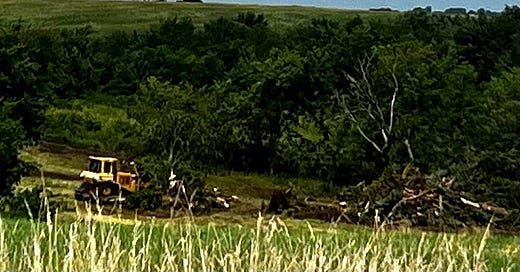Beth Hoffman runs Whippoorwill Creek Farm with her husband John in south central Iowa. She is the author of Bet the Farm: The Dollars and Sense of Growing Food in America.
I could hear the telling clunk, clunk, clunk of the bulldozer even from my house. And by the time I got up the hill to see the machine, I could see it: the heap of trees so common to see in Iowa, a mass of perfectly healthy beings who, just moments before, were standing tall in the wind, now mounded together to be set on fire as soon as they are dry enough to burn.
Far faster than we can plant trees, the neighbors knock them down, trees once lining creeks and rivers, standing amidst the wetlands and at the edge of fields. The days of planting fence row to fence row are alive and well, even in 2024, when the price of corn and soybeans has again plummeted.
Somehow my neighbor missed the lesson on how important trees are, how they help clean the air by replacing carbon dioxide with oxygen. Instead of letting the trees naturally sink carbon deep into the soil via their roots, so many Iowans rip them out to plant corn, later turning the kernels into ethanol, a “clean” energy that requires piping the CO2 hundreds of miles away to bury it again into the ground.
What a crazy concept.
It’s likely the neighbor doesn’t think it’s a big deal to bulldoze trees because, here in Iowa, we change the landscape to fit our needs instead of accepting the geography God gave to us. Iowa is the most altered state in the Union after all. Why have trees when one can create flat, empty fields to pack in a few more rows of corn?
But really, this destruction of trees is a systemic problem.
My neighbor (who, did I mention, likely doesn’t even live here??) is clearly not the only one deforesting the hillsides, creating more erosion and CO2 in the air.
Yet government policies don’t do anything to discourage it—the laws favor one’s “right to farm” over our collective right to have a livable planet. My neighbor will still be able to access the very same highly-subsidized crop insurance as any other farmer if he or she decides to grow corn or soybeans on the newly cleared land.
And if they want to take the land out of production in a few years—likely because it is highly erodible without trees on it—they will be able to receive government payments to stop farming land that shouldn’t have been farmed in the first place.
Conservation? I don’t think so.
I am honored to be a part of the Iowa Writer’s Collaborative. Subscribe to the weekly round up to find out about the latest articles from the group.
Don’t miss these important writers from the Collaborative:






AAARRRGGGGHHH!
I feel your sadness and join you. It is heartbreaking.